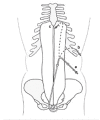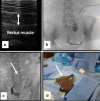Peritoneal Dialysis Catheter Placement: Percutaneous and Peritoneoscopic Techniques
- PMID: 35210729
- PMCID: PMC8856781
- DOI: 10.1055/s-0041-1740940
Peritoneal Dialysis Catheter Placement: Percutaneous and Peritoneoscopic Techniques
Abstract
Chronic peritoneal dialysis (PD) is an underutilized renal replacement therapy in treating end-stage renal disease that has several advantages over hemodialysis. The success of continuous ambulatory PD is largely dependent on a functional long-term access to the peritoneal cavity. Several methods have been developed to place the PD catheter using both surgical and percutaneous techniques. The purpose of this article is to describe the percutaneous techniques using fluoroscopy guidance and peritoneoscope method. While fluoroscopic method uses fluoroscopy guidance and a guidewire to place the PD catheter, the peritoneoscopic technique utilizes a needlescope to directly visualize the peritoneal space to avoid adhesions and omentum during catheter placement. These percutaneous approaches are minimally invasive procedures that can be performed on an outpatient basis without the need for general anesthesia.
Keywords: dialysis; image-guided; interventional; interventional radiology; percutaneous; peritoneal; peritoneoscopic; renal failure.
Thieme. All rights reserved.
Conflict of interest statement
Conflict of Interest A.K.A.-A. is a speaker for Baxter Healthcare. The other authors declare no conflicts of interest associated with this manuscript.
Figures









Similar articles
-
Advanced Image-Guided Percutaneous Technique Versus Advanced Laparoscopic Surgical Technique for Peritoneal Dialysis Catheter Placement.Kidney Med. 2023 Oct 31;6(1):100744. doi: 10.1016/j.xkme.2023.100744. eCollection 2024 Jan. Kidney Med. 2023. PMID: 38188458 Free PMC article.
-
Fluoroscopically guided percutaneous peritoneal dialysis catheter placement: single center experience and review of the literature.Ren Fail. 2010 Jan;32(3):294-9. doi: 10.3109/08860220903548932. Ren Fail. 2010. PMID: 20370443
-
Image-guided tunneled peritoneal dialysis catheter placement.Cardiovasc Diagn Ther. 2023 Feb 28;13(1):311-322. doi: 10.21037/cdt-21-579. Epub 2022 Jan 10. Cardiovasc Diagn Ther. 2023. PMID: 36864963 Free PMC article. Review.
-
Ultrasound/fluoroscopy-assisted placement of peritoneal dialysis catheters.Semin Dial. 2007 Nov-Dec;20(6):611-5. doi: 10.1111/j.1525-139X.2007.00371.x. Semin Dial. 2007. PMID: 17991213
-
Peritoneal dialysis catheter insertion by interventional nephrologists.Adv Chronic Kidney Dis. 2009 Sep;16(5):378-85. doi: 10.1053/j.ackd.2009.06.004. Adv Chronic Kidney Dis. 2009. PMID: 19695506 Review.
Cited by
-
A New, Safe, and Effective Technique for Percutaneous Insertion of a Peritoneal Dialysis Catheter.J Clin Med. 2024 Apr 29;13(9):2618. doi: 10.3390/jcm13092618. J Clin Med. 2024. PMID: 38731147 Free PMC article.
-
Percutaneous Insertion of Peritoneal Dialysis Catheters.Cardiovasc Intervent Radiol. 2025 Jan;48(1):6-15. doi: 10.1007/s00270-024-03873-z. Epub 2024 Oct 7. Cardiovasc Intervent Radiol. 2025. PMID: 39375238 Review.
-
Peritoneal Dialysis Catheter Complications after Insertion by Surgeons, Radiologists, or Nephrologists.J Am Soc Nephrol. 2024 Jan 1;35(1):85-93. doi: 10.1681/ASN.0000000000000250. Epub 2023 Oct 17. J Am Soc Nephrol. 2024. PMID: 37846202 Free PMC article.
References
-
- Golper T A, Guest S, Glickman J D, Turk J, Pulliam J P. Home dialysis in the new USA bundled payment plan: implications and impact. Perit Dial Int. 2011;31(01):12–16. - PubMed
-
- Crabtree J H. Peritoneal dialysis catheter implantation: avoiding problems and optimizing outcomes. Semin Dial. 2015;28(01):12–15. - PubMed
-
- Sinnakirouchenan R, Holley J L. Peritoneal dialysis versus hemodialysis: risks, benefits, and access issues. Adv Chronic Kidney Dis. 2011;18(06):428–432. - PubMed
-
- Berger A, Edelsberg J, Inglese G W, Bhattacharyya S K, Oster G. Cost comparison of peritoneal dialysis versus hemodialysis in end-stage renal disease. Am J Manag Care. 2009;15(08):509–518. - PubMed

